Report on Current Employee Relations Issues in Singapore
VerifiedAdded on 2020/05/16
|9
|2245
|201
Report
AI Summary
This report provides an in-depth analysis of employee relations issues in Singapore, examining the role of the Industrial Relations Act, trade unions, and the tripartite collaboration between the government, National Trades Union Congress (NTUC), and employers. It explores challenges such as the reliance on foreign workers, an aging workforce, and the impact of technological advancements on the labor market. The report discusses the processes of collective bargaining, the function of the Industrial Arbitration Court, and the evolution of the union's role in managing workforce challenges. It further investigates the impact of new business models and changing job dynamics on employee relations. The report concludes by evaluating the future of unions in Singapore and their capacity to adapt to economic developments, employee performance and changing workforce needs.
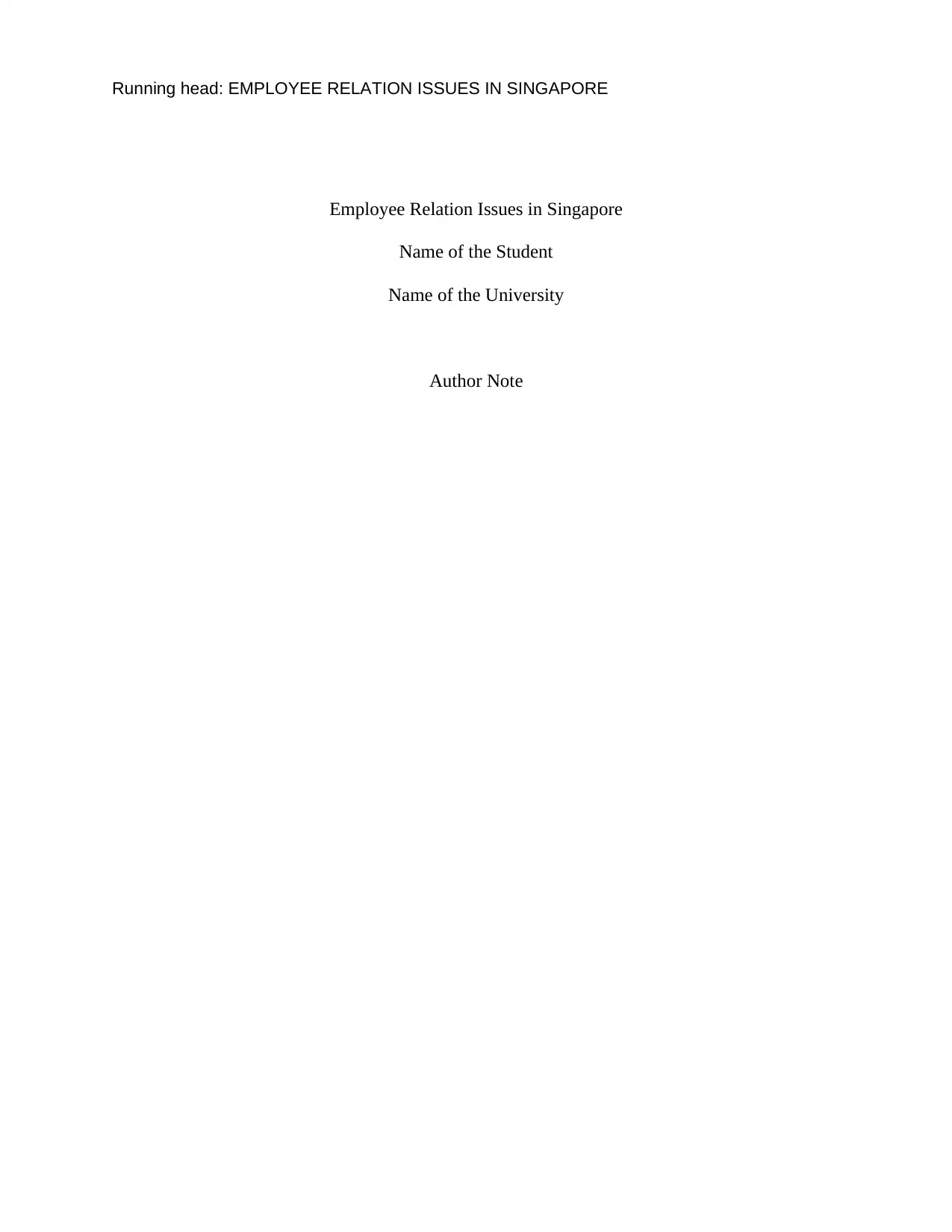
Running head: EMPLOYEE RELATION ISSUES IN SINGAPORE
Employee Relation Issues in Singapore
Name of the Student
Name of the University
Author Note
Employee Relation Issues in Singapore
Name of the Student
Name of the University
Author Note
Paraphrase This Document
Need a fresh take? Get an instant paraphrase of this document with our AI Paraphraser
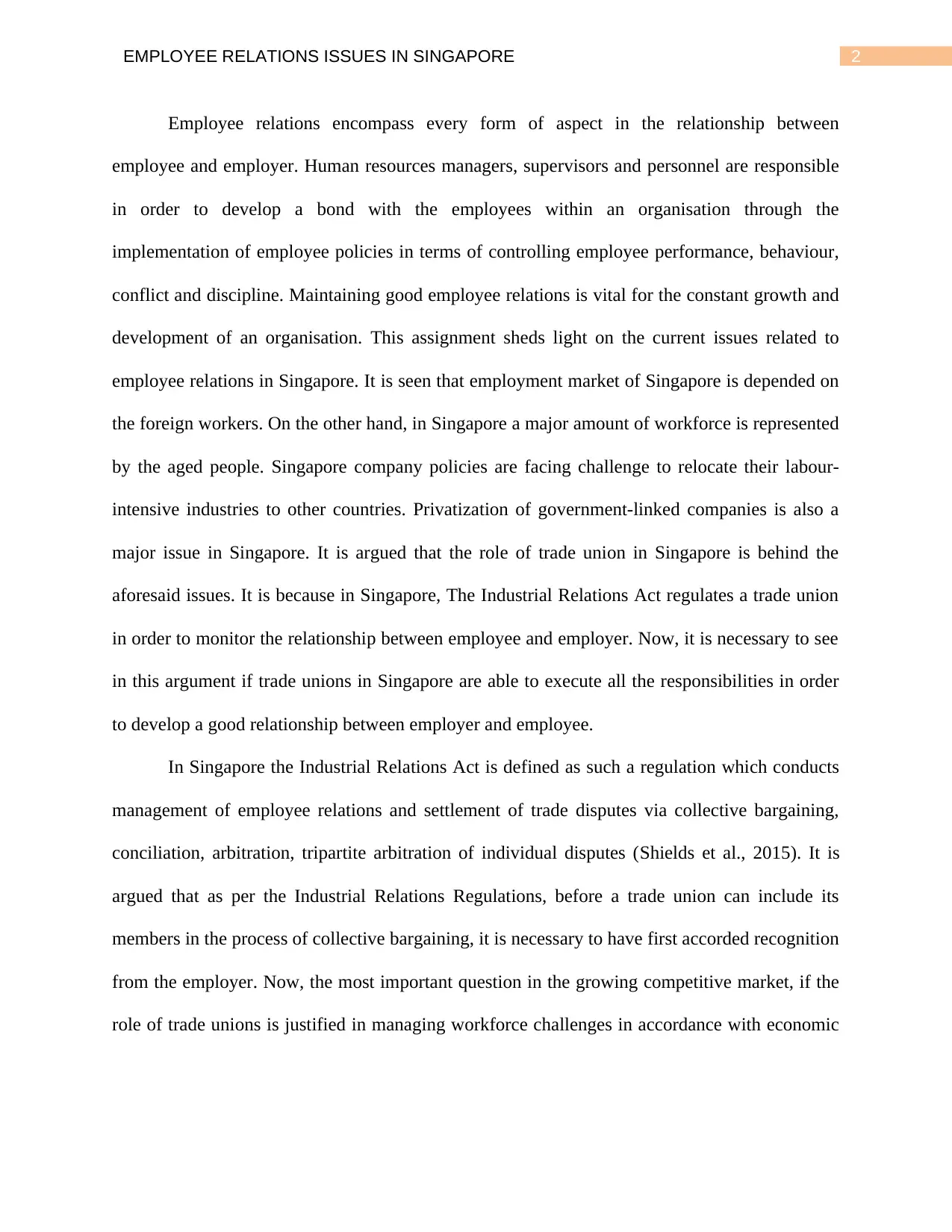
2EMPLOYEE RELATIONS ISSUES IN SINGAPORE
Employee relations encompass every form of aspect in the relationship between
employee and employer. Human resources managers, supervisors and personnel are responsible
in order to develop a bond with the employees within an organisation through the
implementation of employee policies in terms of controlling employee performance, behaviour,
conflict and discipline. Maintaining good employee relations is vital for the constant growth and
development of an organisation. This assignment sheds light on the current issues related to
employee relations in Singapore. It is seen that employment market of Singapore is depended on
the foreign workers. On the other hand, in Singapore a major amount of workforce is represented
by the aged people. Singapore company policies are facing challenge to relocate their labour-
intensive industries to other countries. Privatization of government-linked companies is also a
major issue in Singapore. It is argued that the role of trade union in Singapore is behind the
aforesaid issues. It is because in Singapore, The Industrial Relations Act regulates a trade union
in order to monitor the relationship between employee and employer. Now, it is necessary to see
in this argument if trade unions in Singapore are able to execute all the responsibilities in order
to develop a good relationship between employer and employee.
In Singapore the Industrial Relations Act is defined as such a regulation which conducts
management of employee relations and settlement of trade disputes via collective bargaining,
conciliation, arbitration, tripartite arbitration of individual disputes (Shields et al., 2015). It is
argued that as per the Industrial Relations Regulations, before a trade union can include its
members in the process of collective bargaining, it is necessary to have first accorded recognition
from the employer. Now, the most important question in the growing competitive market, if the
role of trade unions is justified in managing workforce challenges in accordance with economic
Employee relations encompass every form of aspect in the relationship between
employee and employer. Human resources managers, supervisors and personnel are responsible
in order to develop a bond with the employees within an organisation through the
implementation of employee policies in terms of controlling employee performance, behaviour,
conflict and discipline. Maintaining good employee relations is vital for the constant growth and
development of an organisation. This assignment sheds light on the current issues related to
employee relations in Singapore. It is seen that employment market of Singapore is depended on
the foreign workers. On the other hand, in Singapore a major amount of workforce is represented
by the aged people. Singapore company policies are facing challenge to relocate their labour-
intensive industries to other countries. Privatization of government-linked companies is also a
major issue in Singapore. It is argued that the role of trade union in Singapore is behind the
aforesaid issues. It is because in Singapore, The Industrial Relations Act regulates a trade union
in order to monitor the relationship between employee and employer. Now, it is necessary to see
in this argument if trade unions in Singapore are able to execute all the responsibilities in order
to develop a good relationship between employer and employee.
In Singapore the Industrial Relations Act is defined as such a regulation which conducts
management of employee relations and settlement of trade disputes via collective bargaining,
conciliation, arbitration, tripartite arbitration of individual disputes (Shields et al., 2015). It is
argued that as per the Industrial Relations Regulations, before a trade union can include its
members in the process of collective bargaining, it is necessary to have first accorded recognition
from the employer. Now, the most important question in the growing competitive market, if the
role of trade unions is justified in managing workforce challenges in accordance with economic
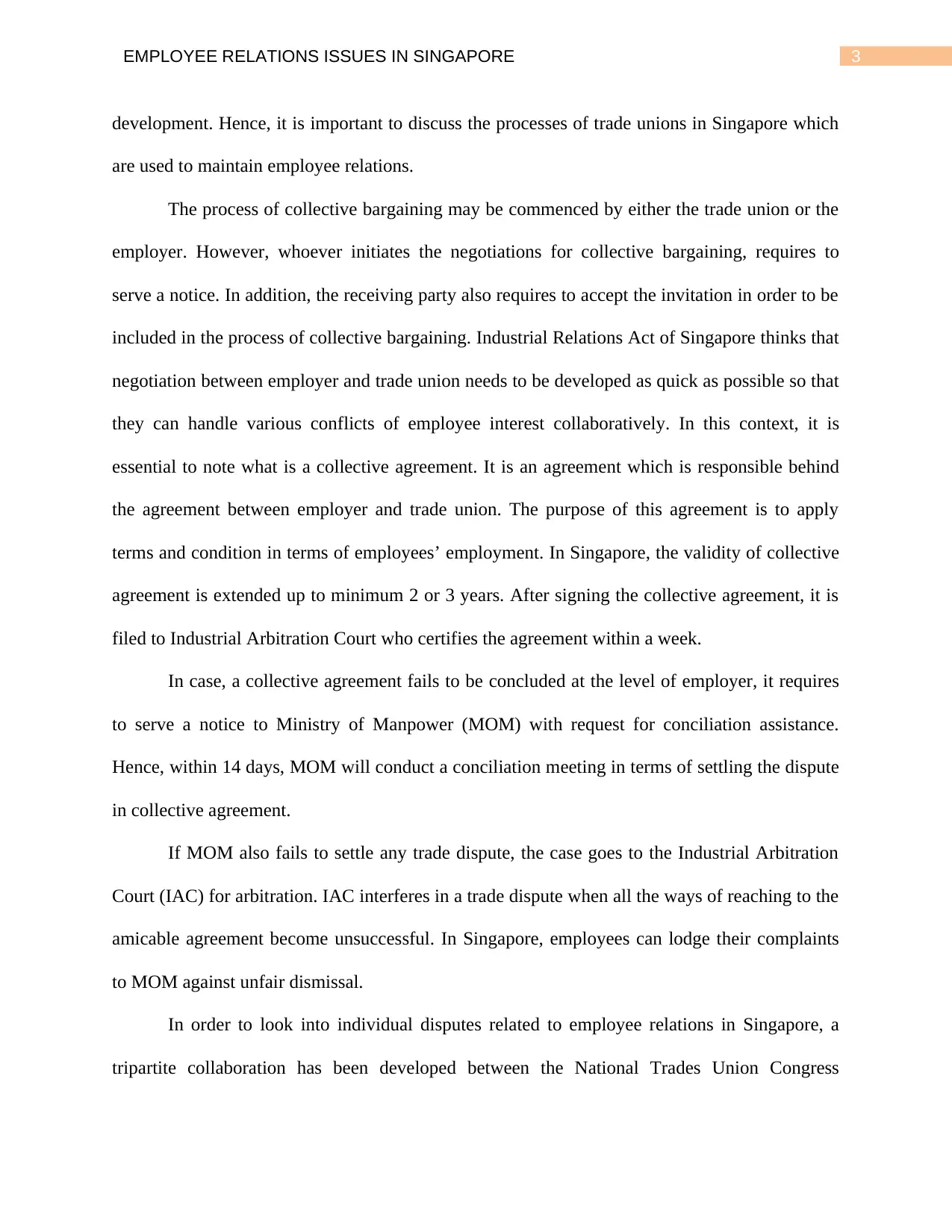
3EMPLOYEE RELATIONS ISSUES IN SINGAPORE
development. Hence, it is important to discuss the processes of trade unions in Singapore which
are used to maintain employee relations.
The process of collective bargaining may be commenced by either the trade union or the
employer. However, whoever initiates the negotiations for collective bargaining, requires to
serve a notice. In addition, the receiving party also requires to accept the invitation in order to be
included in the process of collective bargaining. Industrial Relations Act of Singapore thinks that
negotiation between employer and trade union needs to be developed as quick as possible so that
they can handle various conflicts of employee interest collaboratively. In this context, it is
essential to note what is a collective agreement. It is an agreement which is responsible behind
the agreement between employer and trade union. The purpose of this agreement is to apply
terms and condition in terms of employees’ employment. In Singapore, the validity of collective
agreement is extended up to minimum 2 or 3 years. After signing the collective agreement, it is
filed to Industrial Arbitration Court who certifies the agreement within a week.
In case, a collective agreement fails to be concluded at the level of employer, it requires
to serve a notice to Ministry of Manpower (MOM) with request for conciliation assistance.
Hence, within 14 days, MOM will conduct a conciliation meeting in terms of settling the dispute
in collective agreement.
If MOM also fails to settle any trade dispute, the case goes to the Industrial Arbitration
Court (IAC) for arbitration. IAC interferes in a trade dispute when all the ways of reaching to the
amicable agreement become unsuccessful. In Singapore, employees can lodge their complaints
to MOM against unfair dismissal.
In order to look into individual disputes related to employee relations in Singapore, a
tripartite collaboration has been developed between the National Trades Union Congress
development. Hence, it is important to discuss the processes of trade unions in Singapore which
are used to maintain employee relations.
The process of collective bargaining may be commenced by either the trade union or the
employer. However, whoever initiates the negotiations for collective bargaining, requires to
serve a notice. In addition, the receiving party also requires to accept the invitation in order to be
included in the process of collective bargaining. Industrial Relations Act of Singapore thinks that
negotiation between employer and trade union needs to be developed as quick as possible so that
they can handle various conflicts of employee interest collaboratively. In this context, it is
essential to note what is a collective agreement. It is an agreement which is responsible behind
the agreement between employer and trade union. The purpose of this agreement is to apply
terms and condition in terms of employees’ employment. In Singapore, the validity of collective
agreement is extended up to minimum 2 or 3 years. After signing the collective agreement, it is
filed to Industrial Arbitration Court who certifies the agreement within a week.
In case, a collective agreement fails to be concluded at the level of employer, it requires
to serve a notice to Ministry of Manpower (MOM) with request for conciliation assistance.
Hence, within 14 days, MOM will conduct a conciliation meeting in terms of settling the dispute
in collective agreement.
If MOM also fails to settle any trade dispute, the case goes to the Industrial Arbitration
Court (IAC) for arbitration. IAC interferes in a trade dispute when all the ways of reaching to the
amicable agreement become unsuccessful. In Singapore, employees can lodge their complaints
to MOM against unfair dismissal.
In order to look into individual disputes related to employee relations in Singapore, a
tripartite collaboration has been developed between the National Trades Union Congress
⊘ This is a preview!⊘
Do you want full access?
Subscribe today to unlock all pages.

Trusted by 1+ million students worldwide
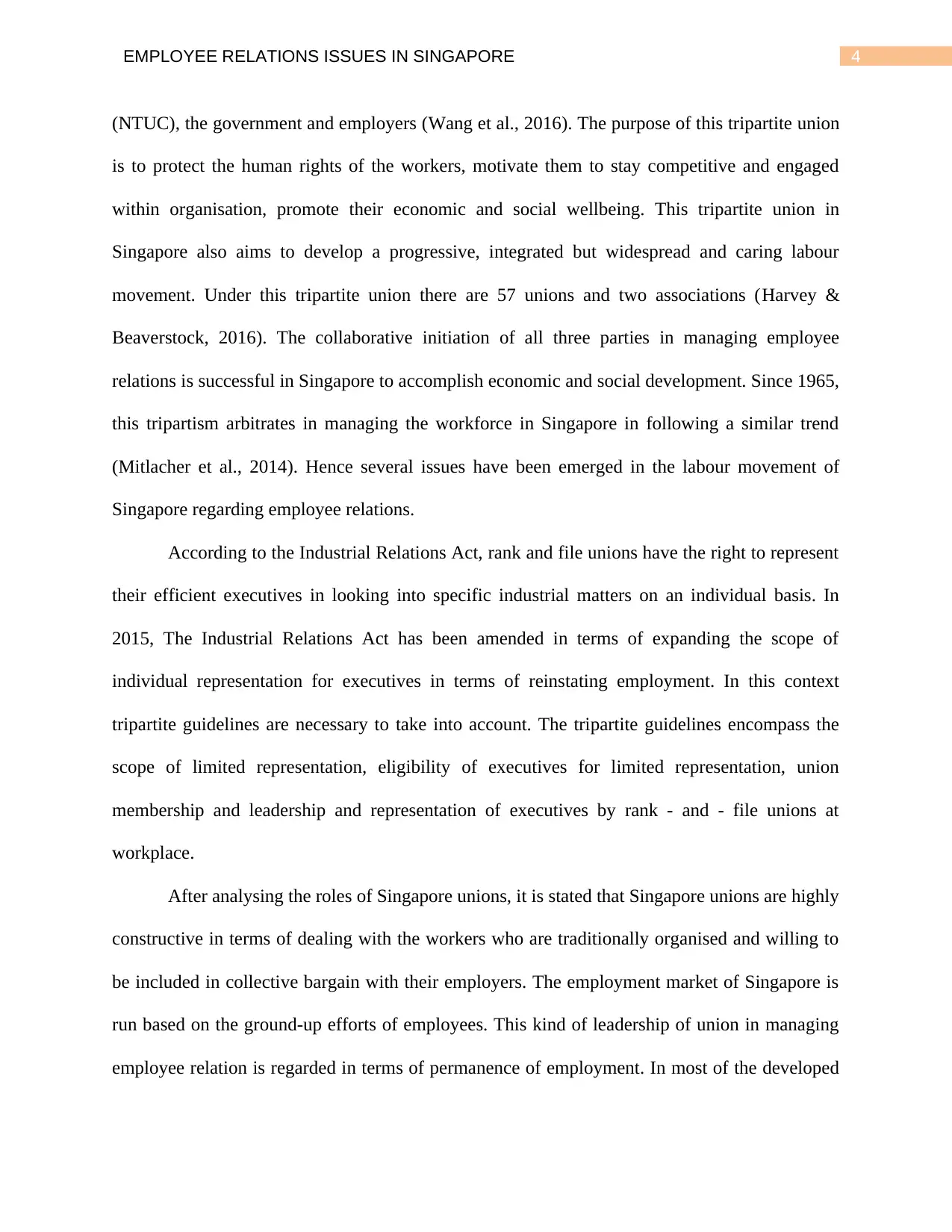
4EMPLOYEE RELATIONS ISSUES IN SINGAPORE
(NTUC), the government and employers (Wang et al., 2016). The purpose of this tripartite union
is to protect the human rights of the workers, motivate them to stay competitive and engaged
within organisation, promote their economic and social wellbeing. This tripartite union in
Singapore also aims to develop a progressive, integrated but widespread and caring labour
movement. Under this tripartite union there are 57 unions and two associations (Harvey &
Beaverstock, 2016). The collaborative initiation of all three parties in managing employee
relations is successful in Singapore to accomplish economic and social development. Since 1965,
this tripartism arbitrates in managing the workforce in Singapore in following a similar trend
(Mitlacher et al., 2014). Hence several issues have been emerged in the labour movement of
Singapore regarding employee relations.
According to the Industrial Relations Act, rank and file unions have the right to represent
their efficient executives in looking into specific industrial matters on an individual basis. In
2015, The Industrial Relations Act has been amended in terms of expanding the scope of
individual representation for executives in terms of reinstating employment. In this context
tripartite guidelines are necessary to take into account. The tripartite guidelines encompass the
scope of limited representation, eligibility of executives for limited representation, union
membership and leadership and representation of executives by rank - and - file unions at
workplace.
After analysing the roles of Singapore unions, it is stated that Singapore unions are highly
constructive in terms of dealing with the workers who are traditionally organised and willing to
be included in collective bargain with their employers. The employment market of Singapore is
run based on the ground-up efforts of employees. This kind of leadership of union in managing
employee relation is regarded in terms of permanence of employment. In most of the developed
(NTUC), the government and employers (Wang et al., 2016). The purpose of this tripartite union
is to protect the human rights of the workers, motivate them to stay competitive and engaged
within organisation, promote their economic and social wellbeing. This tripartite union in
Singapore also aims to develop a progressive, integrated but widespread and caring labour
movement. Under this tripartite union there are 57 unions and two associations (Harvey &
Beaverstock, 2016). The collaborative initiation of all three parties in managing employee
relations is successful in Singapore to accomplish economic and social development. Since 1965,
this tripartism arbitrates in managing the workforce in Singapore in following a similar trend
(Mitlacher et al., 2014). Hence several issues have been emerged in the labour movement of
Singapore regarding employee relations.
According to the Industrial Relations Act, rank and file unions have the right to represent
their efficient executives in looking into specific industrial matters on an individual basis. In
2015, The Industrial Relations Act has been amended in terms of expanding the scope of
individual representation for executives in terms of reinstating employment. In this context
tripartite guidelines are necessary to take into account. The tripartite guidelines encompass the
scope of limited representation, eligibility of executives for limited representation, union
membership and leadership and representation of executives by rank - and - file unions at
workplace.
After analysing the roles of Singapore unions, it is stated that Singapore unions are highly
constructive in terms of dealing with the workers who are traditionally organised and willing to
be included in collective bargain with their employers. The employment market of Singapore is
run based on the ground-up efforts of employees. This kind of leadership of union in managing
employee relation is regarded in terms of permanence of employment. In most of the developed
Paraphrase This Document
Need a fresh take? Get an instant paraphrase of this document with our AI Paraphraser
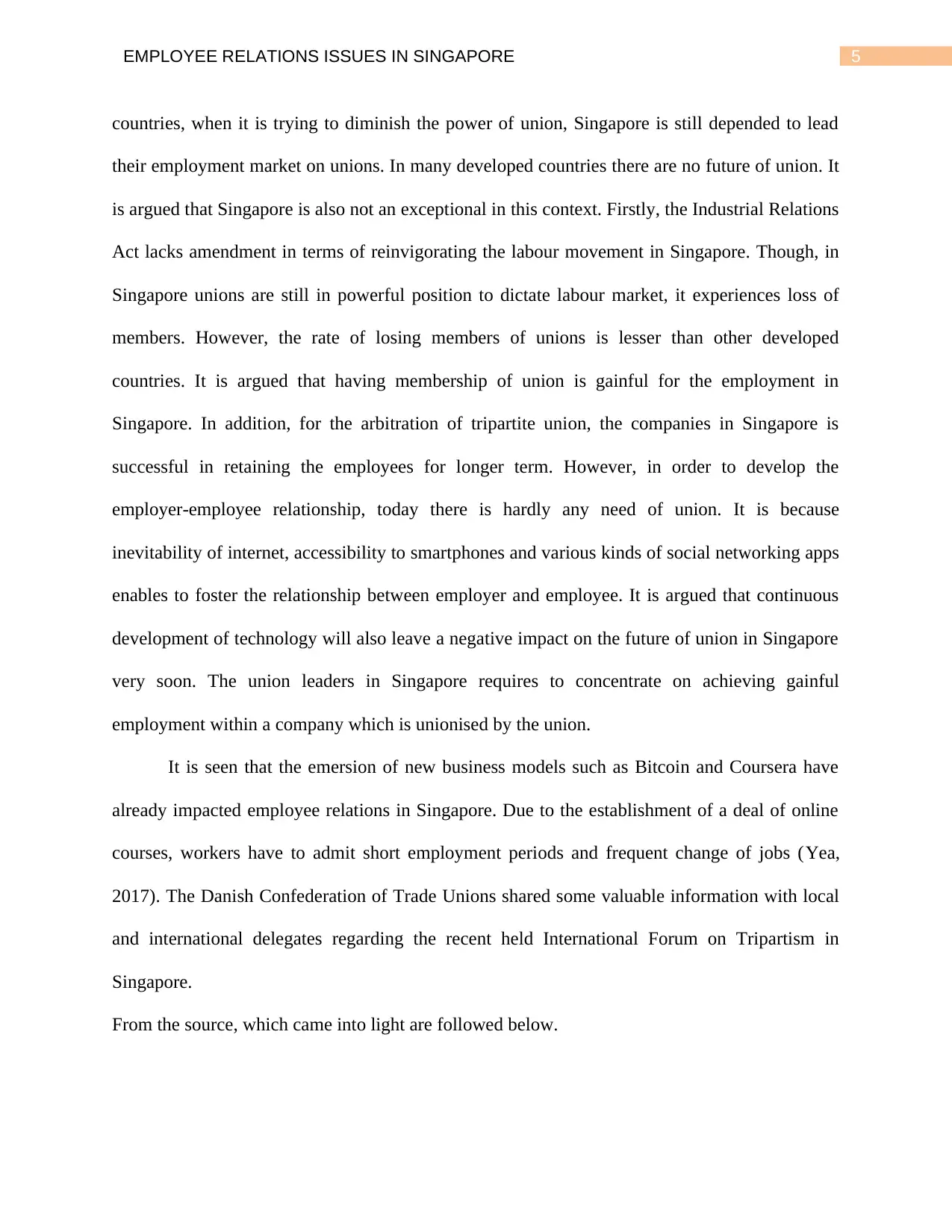
5EMPLOYEE RELATIONS ISSUES IN SINGAPORE
countries, when it is trying to diminish the power of union, Singapore is still depended to lead
their employment market on unions. In many developed countries there are no future of union. It
is argued that Singapore is also not an exceptional in this context. Firstly, the Industrial Relations
Act lacks amendment in terms of reinvigorating the labour movement in Singapore. Though, in
Singapore unions are still in powerful position to dictate labour market, it experiences loss of
members. However, the rate of losing members of unions is lesser than other developed
countries. It is argued that having membership of union is gainful for the employment in
Singapore. In addition, for the arbitration of tripartite union, the companies in Singapore is
successful in retaining the employees for longer term. However, in order to develop the
employer-employee relationship, today there is hardly any need of union. It is because
inevitability of internet, accessibility to smartphones and various kinds of social networking apps
enables to foster the relationship between employer and employee. It is argued that continuous
development of technology will also leave a negative impact on the future of union in Singapore
very soon. The union leaders in Singapore requires to concentrate on achieving gainful
employment within a company which is unionised by the union.
It is seen that the emersion of new business models such as Bitcoin and Coursera have
already impacted employee relations in Singapore. Due to the establishment of a deal of online
courses, workers have to admit short employment periods and frequent change of jobs (Yea,
2017). The Danish Confederation of Trade Unions shared some valuable information with local
and international delegates regarding the recent held International Forum on Tripartism in
Singapore.
From the source, which came into light are followed below.
countries, when it is trying to diminish the power of union, Singapore is still depended to lead
their employment market on unions. In many developed countries there are no future of union. It
is argued that Singapore is also not an exceptional in this context. Firstly, the Industrial Relations
Act lacks amendment in terms of reinvigorating the labour movement in Singapore. Though, in
Singapore unions are still in powerful position to dictate labour market, it experiences loss of
members. However, the rate of losing members of unions is lesser than other developed
countries. It is argued that having membership of union is gainful for the employment in
Singapore. In addition, for the arbitration of tripartite union, the companies in Singapore is
successful in retaining the employees for longer term. However, in order to develop the
employer-employee relationship, today there is hardly any need of union. It is because
inevitability of internet, accessibility to smartphones and various kinds of social networking apps
enables to foster the relationship between employer and employee. It is argued that continuous
development of technology will also leave a negative impact on the future of union in Singapore
very soon. The union leaders in Singapore requires to concentrate on achieving gainful
employment within a company which is unionised by the union.
It is seen that the emersion of new business models such as Bitcoin and Coursera have
already impacted employee relations in Singapore. Due to the establishment of a deal of online
courses, workers have to admit short employment periods and frequent change of jobs (Yea,
2017). The Danish Confederation of Trade Unions shared some valuable information with local
and international delegates regarding the recent held International Forum on Tripartism in
Singapore.
From the source, which came into light are followed below.
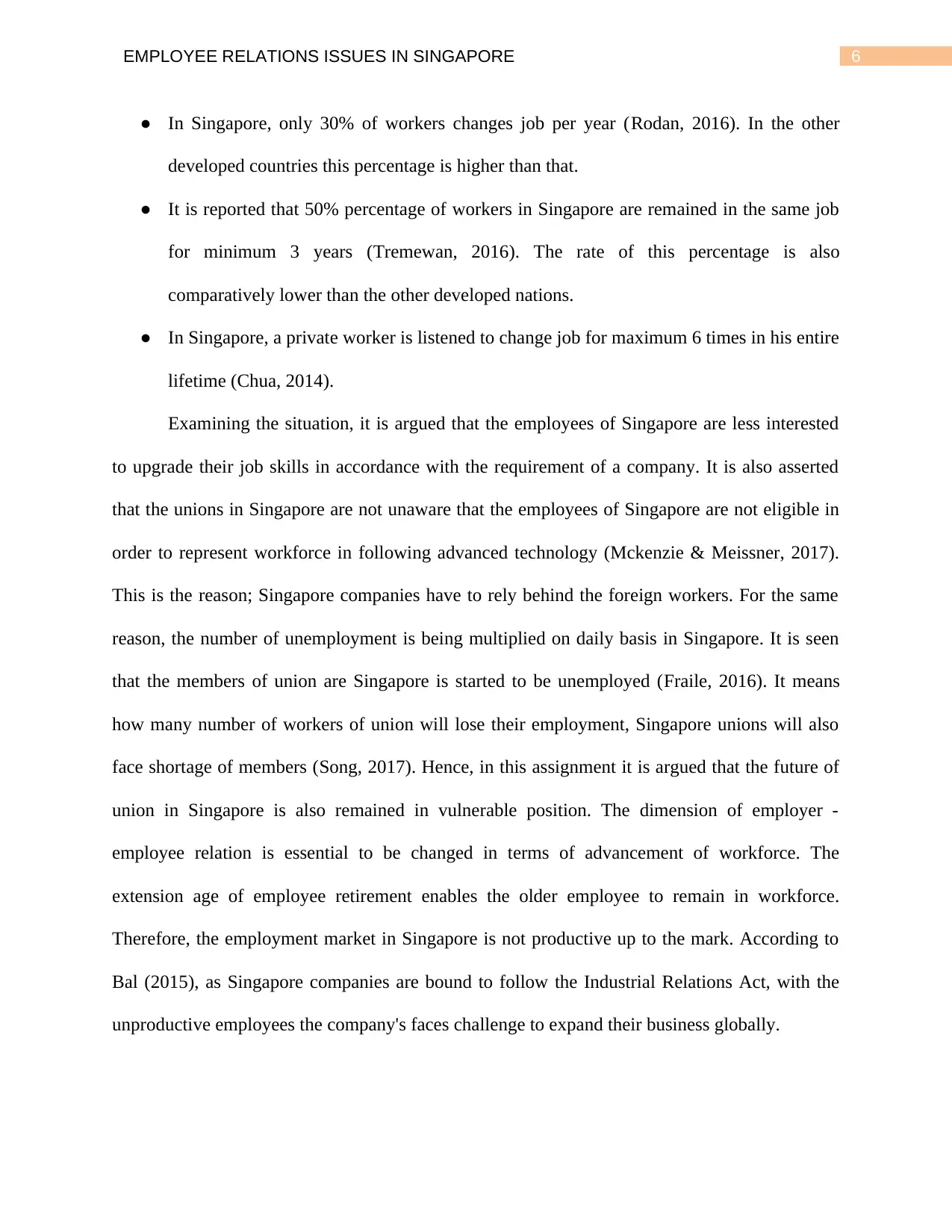
6EMPLOYEE RELATIONS ISSUES IN SINGAPORE
● In Singapore, only 30% of workers changes job per year (Rodan, 2016). In the other
developed countries this percentage is higher than that.
● It is reported that 50% percentage of workers in Singapore are remained in the same job
for minimum 3 years (Tremewan, 2016). The rate of this percentage is also
comparatively lower than the other developed nations.
● In Singapore, a private worker is listened to change job for maximum 6 times in his entire
lifetime (Chua, 2014).
Examining the situation, it is argued that the employees of Singapore are less interested
to upgrade their job skills in accordance with the requirement of a company. It is also asserted
that the unions in Singapore are not unaware that the employees of Singapore are not eligible in
order to represent workforce in following advanced technology (Mckenzie & Meissner, 2017).
This is the reason; Singapore companies have to rely behind the foreign workers. For the same
reason, the number of unemployment is being multiplied on daily basis in Singapore. It is seen
that the members of union are Singapore is started to be unemployed (Fraile, 2016). It means
how many number of workers of union will lose their employment, Singapore unions will also
face shortage of members (Song, 2017). Hence, in this assignment it is argued that the future of
union in Singapore is also remained in vulnerable position. The dimension of employer -
employee relation is essential to be changed in terms of advancement of workforce. The
extension age of employee retirement enables the older employee to remain in workforce.
Therefore, the employment market in Singapore is not productive up to the mark. According to
Bal (2015), as Singapore companies are bound to follow the Industrial Relations Act, with the
unproductive employees the company's faces challenge to expand their business globally.
● In Singapore, only 30% of workers changes job per year (Rodan, 2016). In the other
developed countries this percentage is higher than that.
● It is reported that 50% percentage of workers in Singapore are remained in the same job
for minimum 3 years (Tremewan, 2016). The rate of this percentage is also
comparatively lower than the other developed nations.
● In Singapore, a private worker is listened to change job for maximum 6 times in his entire
lifetime (Chua, 2014).
Examining the situation, it is argued that the employees of Singapore are less interested
to upgrade their job skills in accordance with the requirement of a company. It is also asserted
that the unions in Singapore are not unaware that the employees of Singapore are not eligible in
order to represent workforce in following advanced technology (Mckenzie & Meissner, 2017).
This is the reason; Singapore companies have to rely behind the foreign workers. For the same
reason, the number of unemployment is being multiplied on daily basis in Singapore. It is seen
that the members of union are Singapore is started to be unemployed (Fraile, 2016). It means
how many number of workers of union will lose their employment, Singapore unions will also
face shortage of members (Song, 2017). Hence, in this assignment it is argued that the future of
union in Singapore is also remained in vulnerable position. The dimension of employer -
employee relation is essential to be changed in terms of advancement of workforce. The
extension age of employee retirement enables the older employee to remain in workforce.
Therefore, the employment market in Singapore is not productive up to the mark. According to
Bal (2015), as Singapore companies are bound to follow the Industrial Relations Act, with the
unproductive employees the company's faces challenge to expand their business globally.
⊘ This is a preview!⊘
Do you want full access?
Subscribe today to unlock all pages.

Trusted by 1+ million students worldwide
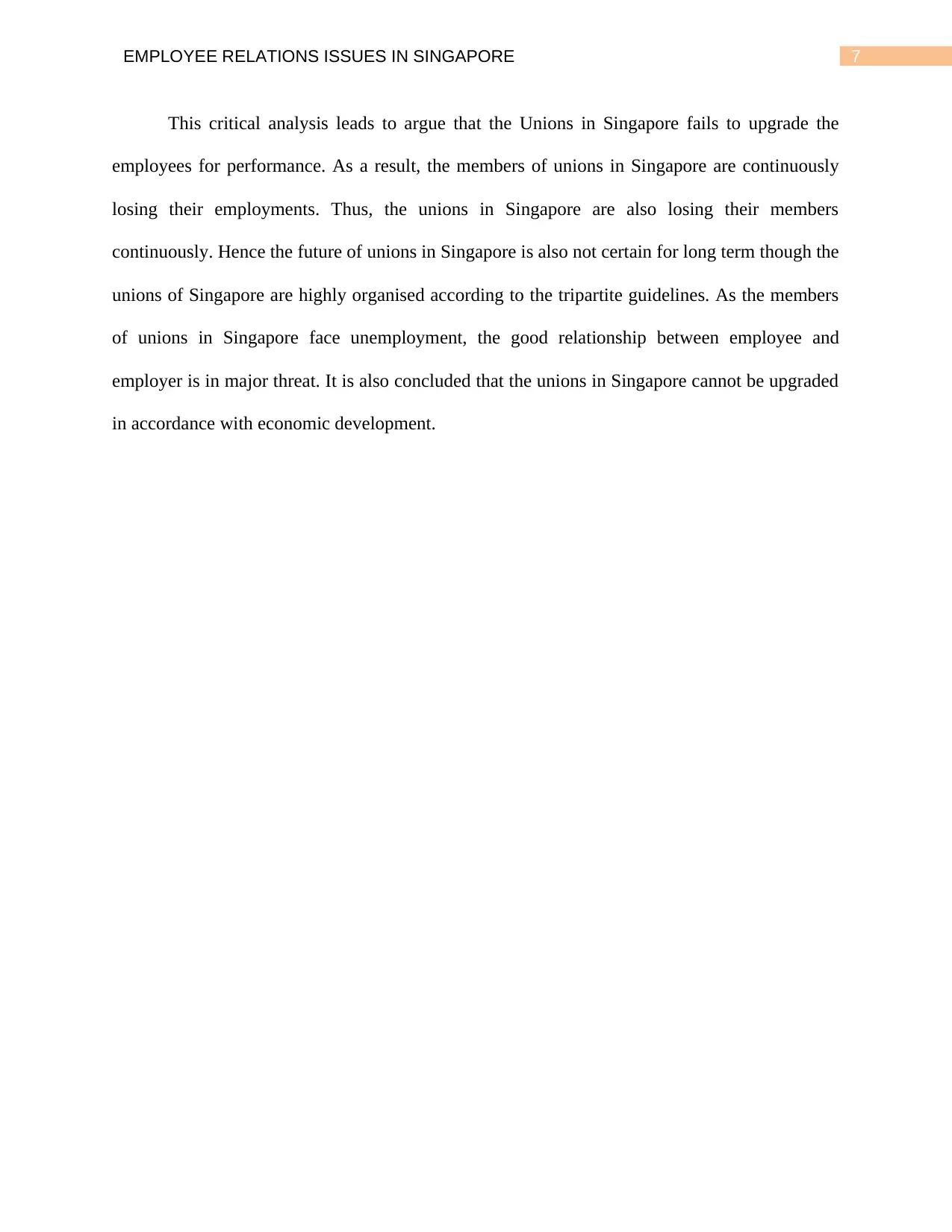
7EMPLOYEE RELATIONS ISSUES IN SINGAPORE
This critical analysis leads to argue that the Unions in Singapore fails to upgrade the
employees for performance. As a result, the members of unions in Singapore are continuously
losing their employments. Thus, the unions in Singapore are also losing their members
continuously. Hence the future of unions in Singapore is also not certain for long term though the
unions of Singapore are highly organised according to the tripartite guidelines. As the members
of unions in Singapore face unemployment, the good relationship between employee and
employer is in major threat. It is also concluded that the unions in Singapore cannot be upgraded
in accordance with economic development.
This critical analysis leads to argue that the Unions in Singapore fails to upgrade the
employees for performance. As a result, the members of unions in Singapore are continuously
losing their employments. Thus, the unions in Singapore are also losing their members
continuously. Hence the future of unions in Singapore is also not certain for long term though the
unions of Singapore are highly organised according to the tripartite guidelines. As the members
of unions in Singapore face unemployment, the good relationship between employee and
employer is in major threat. It is also concluded that the unions in Singapore cannot be upgraded
in accordance with economic development.
Paraphrase This Document
Need a fresh take? Get an instant paraphrase of this document with our AI Paraphraser

8EMPLOYEE RELATIONS ISSUES IN SINGAPORE
Reference list
Bal, C. S. (2015). Production politics and migrant labour advocacy in Singapore. Journal of
Contemporary Asia, 45(2), 219-242.
Chua, B. H. (2014). Navigating between limits: the future of public housing in Singapore.
Housing Studies, 29(4), 520-533.
Fraile, L. (Ed.). (2016). Blunting neoliberalism: tripartism and economic reforms in the
developing world. Springer.
Harvey, W., & Beaverstock, J. (2016). Diverging experiences of work and social networks
abroad: Highly-skilled British migrants in Singapore, Vancouver and Boston.
Mckenzie, L., & Meissner, K. L. (2017). Human rights conditionality in European Union trade
negotiations: The case of the EU–Singapore FTA. JCMS: Journal of Common Market
Studies, 55(4), 832-849.
Mitlacher, L., Waring, P., Burgess, J., & Connell, J. (2014). Agency work and agency workers-
employee representation in Germany and Singapore. International Journal of
Employment Studies, 22(2), 6.
Rodan, G. (2016). The political economy of Singapore's industrialization: national state and
international capital. Springer.
Shields, J., Brown, M., Kaine, S., Dolle-Samuel, C., North-Samardzic, A., McLean, P., ... &
Plimmer, G. (2015). Managing Employee Performance & Reward: Concepts, Practices,
Strategies. Cambridge University Press.
Song, J. (Ed.). (2017). A History of Human Rights Society in Singapore: 1965-2015. Taylor &
Francis.
Tremewan, C. (2016). The political economy of social control in Singapore. Springer.
Reference list
Bal, C. S. (2015). Production politics and migrant labour advocacy in Singapore. Journal of
Contemporary Asia, 45(2), 219-242.
Chua, B. H. (2014). Navigating between limits: the future of public housing in Singapore.
Housing Studies, 29(4), 520-533.
Fraile, L. (Ed.). (2016). Blunting neoliberalism: tripartism and economic reforms in the
developing world. Springer.
Harvey, W., & Beaverstock, J. (2016). Diverging experiences of work and social networks
abroad: Highly-skilled British migrants in Singapore, Vancouver and Boston.
Mckenzie, L., & Meissner, K. L. (2017). Human rights conditionality in European Union trade
negotiations: The case of the EU–Singapore FTA. JCMS: Journal of Common Market
Studies, 55(4), 832-849.
Mitlacher, L., Waring, P., Burgess, J., & Connell, J. (2014). Agency work and agency workers-
employee representation in Germany and Singapore. International Journal of
Employment Studies, 22(2), 6.
Rodan, G. (2016). The political economy of Singapore's industrialization: national state and
international capital. Springer.
Shields, J., Brown, M., Kaine, S., Dolle-Samuel, C., North-Samardzic, A., McLean, P., ... &
Plimmer, G. (2015). Managing Employee Performance & Reward: Concepts, Practices,
Strategies. Cambridge University Press.
Song, J. (Ed.). (2017). A History of Human Rights Society in Singapore: 1965-2015. Taylor &
Francis.
Tremewan, C. (2016). The political economy of social control in Singapore. Springer.
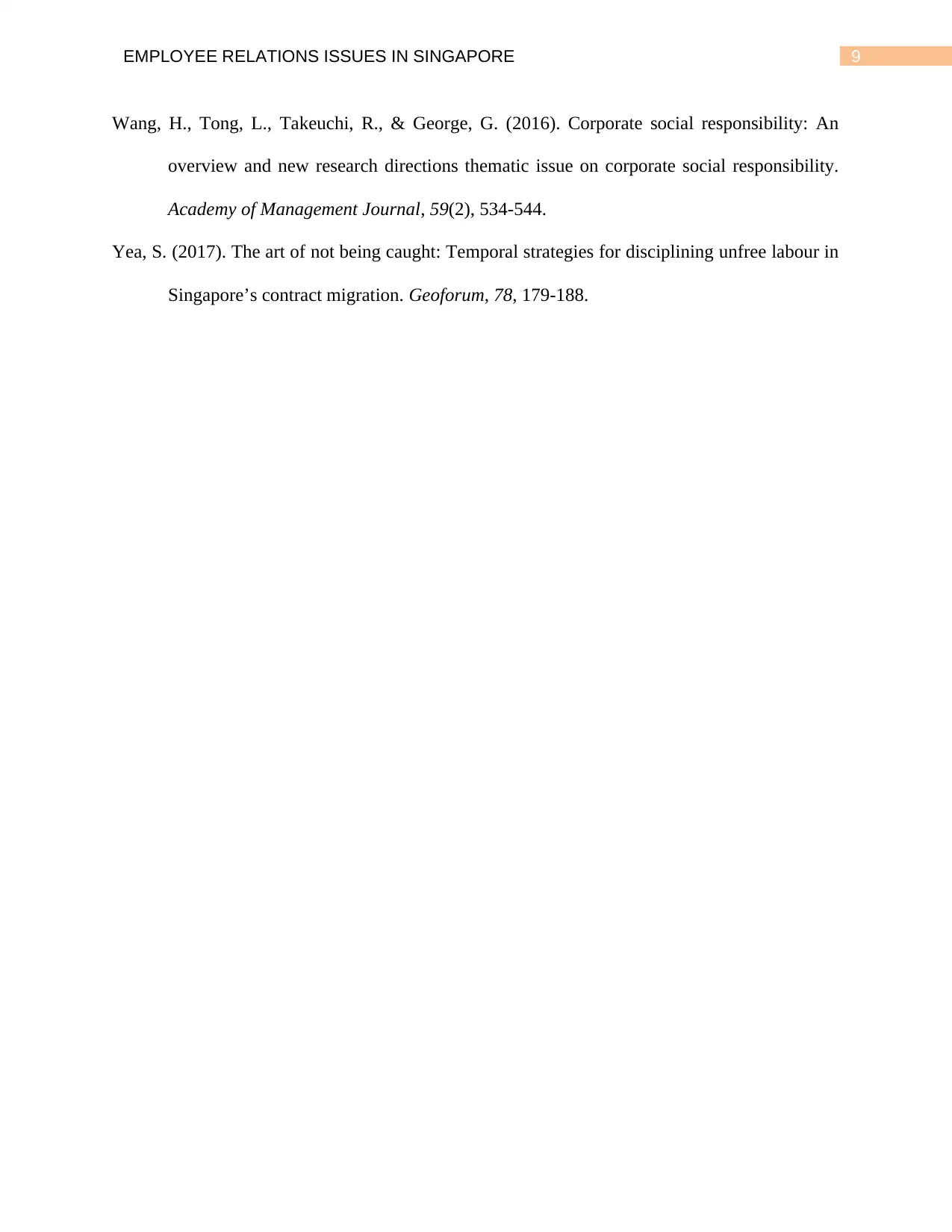
9EMPLOYEE RELATIONS ISSUES IN SINGAPORE
Wang, H., Tong, L., Takeuchi, R., & George, G. (2016). Corporate social responsibility: An
overview and new research directions thematic issue on corporate social responsibility.
Academy of Management Journal, 59(2), 534-544.
Yea, S. (2017). The art of not being caught: Temporal strategies for disciplining unfree labour in
Singapore’s contract migration. Geoforum, 78, 179-188.
Wang, H., Tong, L., Takeuchi, R., & George, G. (2016). Corporate social responsibility: An
overview and new research directions thematic issue on corporate social responsibility.
Academy of Management Journal, 59(2), 534-544.
Yea, S. (2017). The art of not being caught: Temporal strategies for disciplining unfree labour in
Singapore’s contract migration. Geoforum, 78, 179-188.
⊘ This is a preview!⊘
Do you want full access?
Subscribe today to unlock all pages.

Trusted by 1+ million students worldwide
1 out of 9
Related Documents
Your All-in-One AI-Powered Toolkit for Academic Success.
+13062052269
info@desklib.com
Available 24*7 on WhatsApp / Email
![[object Object]](/_next/static/media/star-bottom.7253800d.svg)
Unlock your academic potential
Copyright © 2020–2025 A2Z Services. All Rights Reserved. Developed and managed by ZUCOL.





